A Buyer’s Guide to Copper Sinks
ABOUT
Hello, everyone. I’m Lesley.
I’m not the kind of person who does anything lightly. I like to know everything I can about whatever it is I’m doing before I get to doing it so I can make confident decisions. This is where I’ve shared the information I gathered along my copper sink buying journey. From the nature of copper to the difference between copper patina and copper finishes, to manufacturing styles of copper sinks.
HOW DID THIS WEBSITE HAPPEN?
In 2007, my best friend Josie and I took a trip to the Virgin Islands. Our hotel had copper bathroom sinks and I fell completely in love; I never stopped thinking about having copper sinks in my house one day. In 2009, I bought my home, and two years later I finished remodeling just about every bit of it—complete with copper bathroom AND copper kitchen sinks!
About a month after the remodel was complete, Josie and I were grabbing a bite to eat when she asked if I would mind talking to her friend who was remodeling a bathroom. “Of course not!” I said. Three weeks later, Josie’s friend asked me to talk to her coworker. “I’d be happy to!” I was on the phone with the coworker for about an hour when he mentioned perhaps I could get in touch with his son, since it was actually for him that he was getting all this information, anyway. “Oh! Sure…” Days later I was on the phone with the son, who wanted me to talk to his partner, instead… You see the pattern here.
Two months after the remodel, I half-jokingly said to Josie “I should just make a website so I don’t have to share all of this information over and over!”
So, thanks to them, here I am relaying as much of my experience as I can, and then getting back to the other things I enjoy as much as I’ve enjoyed this journey. Meanwhile, this site will stick around as a resource for anyone who comes along! Win-win!
A LITTLE BIT ABOUT COPPER
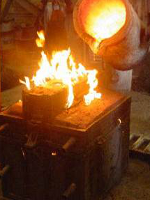 To understand the basics of your copper sink, you must first understand the nature of
copper. Copper has been around forever; it is an element of the known universe and, as far as
anyone can tell, it always will be. Ancient civilizations started mining and utilizing copper
thousands of years ago, and eventually figured out the smelting process—creating copper alloys
like bronze and brass. There is an entire era in human history based on the development and use of
these alloys—The Bronze Age—but I digress…
To understand the basics of your copper sink, you must first understand the nature of
copper. Copper has been around forever; it is an element of the known universe and, as far as
anyone can tell, it always will be. Ancient civilizations started mining and utilizing copper
thousands of years ago, and eventually figured out the smelting process—creating copper alloys
like bronze and brass. There is an entire era in human history based on the development and use of
these alloys—The Bronze Age—but I digress…
One of the most incredible things about copper is its reusability. It is said that 80-90% of all the copper EVER used is STILL in use. This is possible because, contrary to popular belief, there is no structural difference between recycled (secondary) copper and virgin (primary) copper. Although secondary copper has been reclaimed from old objects, melted down, refined and formed into new objects while primary copper originates from ores, they are indistinguishable. Copper can be recycled without losing any without losing any physical or chemical properties, that is, without losing any structural integrity. One of those properties is being naturally, organically, inherently antimicrobial, making copper a preferred material in the use of healthcare facilities, as well as food and public service buildings… and, perhaps, your bathroom and kitchen!
COPPER SINK CONSTRUCTION
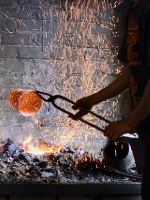 Copper sinks should be made out of 99% pure copper with 1% zinc for added strength and
integrity. Copper alloys containing lead are sometimes used in sinks made in the Middle East,
India and China. Lead has similar workability properties to copper and is quite inexpensive, but
it is not meant for human consumption and should be avoided.
Copper sinks should be made out of 99% pure copper with 1% zinc for added strength and
integrity. Copper alloys containing lead are sometimes used in sinks made in the Middle East,
India and China. Lead has similar workability properties to copper and is quite inexpensive, but
it is not meant for human consumption and should be avoided.
Due to their size, copper kitchen sinks almost always include welded seams, which should be TIG welded with copper rod. Copper sinks should not be soldered! Soldered seams appear grey with time, will eventually leak, and could contain lead.
Another major factor is the drain opening which will need to be the correct size to meet code for your application. The position of the drain is a matter of preference. Most homeowners prefer sinks with a centered drain opening—this easily fits standard installations. Large commercial kitchen sinks often have the opening for the drain and the faucet positioned off-center, to the side, to allow for use of the water at one end while pots and pans awaiting washing are stacked at the other. Copper sinks can be custom made with the drain in the position you require. Regardless of where the drain is placed, the bottom should slope gently toward the drain.
SMOOTH vs. HAMMERED
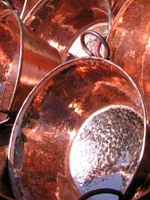 Smooth copper sinks are manufactured, often mass-produced, by machine with a mold or
press. “Hand-Hammered” sinks feature a textured surface created by the hammering
techniques used as they are made one by one, by hand, in small artisan shops. What is your style
preference? Are you fitting a sink to existing décor? A smooth copper sink usually has modern and
industrial style appeal, while a hammered copper sink has a warm, hand-crafted appeal that fits
well to rustic, eclectic, traditional, as well as contemporary décor.
Smooth copper sinks are manufactured, often mass-produced, by machine with a mold or
press. “Hand-Hammered” sinks feature a textured surface created by the hammering
techniques used as they are made one by one, by hand, in small artisan shops. What is your style
preference? Are you fitting a sink to existing décor? A smooth copper sink usually has modern and
industrial style appeal, while a hammered copper sink has a warm, hand-crafted appeal that fits
well to rustic, eclectic, traditional, as well as contemporary décor.
Next, think about your lifestyle. Will the sink receive a lot of love from children, or be heavily used by enthusiastic cooks? A smooth surface copper sink will be more difficult to maintain in a busy kitchen and will show dings and scratches. This may be of no consequence in a commercial kitchen where function is the priority while in a home-setting, aesthetic is significant and the more forgiving hammered surface may be a wise decision. In addition, hammering copper has a hardening effect on the metal—one reason copper smiths have hammered copper for ages—which may lead to a more durable surface than that of smooth copper.
The hammered texture not only adds character and beauty, but also strengthens the surface and helps camouflage those small marks that occur with everyday use. US copper sink fabricators have traditionally focused primarily on commercial projects such as large restaurant kitchen sinks with smooth, rather than hammered, finishes and more standardized rectangular shapes.
Well-made copper sinks are properly shaped. Though hand-hammered products won’t ever be perfectly shaped, they definitely should not be “out-of-square” or “out-of-round”. Avoid any sink that is noticeably misshapen… such a sink should only be sold as a second.
WHAT IS COPPER GAUGE AND HOW DOES IT AFFECT A SINK?
Gauge is a measurement of the thickness of the copper material; it is sometimes referred to by the weight per square foot. Traditionally, the lower the number, the thicker the gauge:
20 gauge - Thinnest
18 gauge - Thin
16 gauge - Thick
14 gauge - Thickest
The thickness of copper used in the construction of sinks varies greatly. Copper is a soft metal and the thickness can have a dramatic effect on how well the sink wears over time. This is especially important for kitchen sinks that undergo a constant barrage of pots, pans, tools and cleaning products.
You’ll find bath sinks made from 20 gauge to 16 gauge copper, while most standard kitchen and farmhouse kitchen sinks range from 18 gauge to 14 gauge. When shopping for copper sinks, always ask about the gauge. A thicker gauge sink will be more expensive and, in most cases, well worth the extra cost. A lighter gauge metal can sometimes produce a tinny sound when the faucet is turned on and water drums on the sink surface. Thinner gauge copper will also dent more easily, which is a large consideration, especially for kitchen sinks. You will sometimes find lower-quality sinks insulated with foam blocks in an effort to help muffle the sound. Yikes!
COPPER KITCHEN SINKS
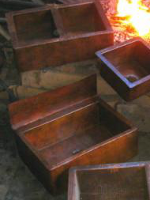 Copper Kitchen Sinks come in standard kitchen and farmhouse (apron-front) styles.
Copper Kitchen Sinks come in standard kitchen and farmhouse (apron-front) styles.
The standard copper kitchen sink is installed as either an under-mount or a drop-in (also known as a top-mount) sink; they feature a flat rim (or lip or flange) along the top of the sink for mounting. There is counter space between the user and the sink basin.
The farmhouse copper kitchen sink features a finished, double-wall apron front and is installed into a cabinet with the apron replacing the front of the cabinet—there are approximately two-inches between the user and the basin of the sink.
Both standard and farmhouse sinks come in a variety of designs, sizes, shapes and in different configurations—i.e. single-, double- and even triple-bowl versions.
COPPER BATHROOM SINKS
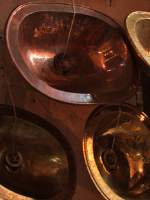 Bathroom sinks are generally available in standard and vessel sink styles.
Bathroom sinks are generally available in standard and vessel sink styles.
As with standard kitchen sinks, standard bathroom sinks are installed as either an under-mount or drop-in sink. Some sinks are designed with a decorative lip or rim (a rope lip, a rolled rim, etc.) specifically for drop-in applications.
Vessel sinks are designed to sit on top of, or partially recessed into the bathroom counter. They are a stylistic development in sink design, and sometimes require a special vessel filler faucet.
PATINA & FINISHES
Patina is a naturally occurring, film-like tarnish that develops on copper over time. (Fun fact: it also develops on wooded furniture, like pianos. Antiques are often appraised by their patina.) The best way to illustrate a copper patina is to dip into your piggy bank and select a wide range of pennies and arrange them from lightest to darkest. The brand new penny will be the lightest, and will have the most luster. This is copper without patina—super shiny! Now, as you follow the pennies from light to dark, you will be seeing the patina “develop”. The more often copper is used (and exposed to air!) the more patina develops.
A natural patina is a warm caramel, or milk chocolate color and can take anywhere from six weeks to a year to develop depending on the use of the copper. With exposure to really harsh elements (salt water and the like) the patina can become green—this is called verdigris. This doesn’t happen to copper sinks often, because they are at use indoors, and, well, not by the sea, or in storms. This green look is desirable to some, and some manufacturers have even discovered ways to make the copper look verdigris.
Some people prefer an un-finished, shiny copper sink. This is either because they prefer the shiny look—which needs to be maintained with a copper cleaner every six weeks or so—or because they want to watch the shiny “new” copper develop patina. This was my first choice, but I wanted a sink darker than copper’s natural patina. I love the idea of “growing old” with my sink. I know, I’m a sap, but I think the process is so interesting, and nothing beats having a story, or history, with a product. It can take several years, but the results are incomparable. Once the desired patina is reached, using a protective microcrystalline wax will slow down the patina process and sink will remain relatively the same.
Copper sinks are available in a wide range of finishes. What you choose is a matter of personal taste and your chosen kitchen or bathroom décor. It should be noted that any copper sink with a finish will need to be maintained with a protective microcrystalline wax (I use Renaissance Wax) every 4 – 6 weeks. Any substance with high acidic content will act as a copper cleaner and shine the finish right off the surface of your sink, leaving you with a bright and shiny copper spot. The wax will help protect this from happening. Don’t fret too much, though. If you forget to wax, and you wake up to find a brand-new-penny-situation in your sink from lemon or pickle juice or, my favorite, toothpaste left in your sink, it will re-patina with time! Just be patient, and try not to let your OCD get the best of you.
You can find warm, caramel finished copper sinks designed to take on the look of copper’s natural patina. These sinks are often considered the easiest to maintain. If something shines the copper, leaving you with a bright and shiny situation, the finish will seem to “heal itself” as the patina darkens and blends in with the finish. Finishes like these are sometimes called “self-healing”.
I went with a dark chocolate, espresso-y finish that is much darker than a natural patina. These and other “unnatural” finishes require the most maintenance because the healing patina will never match. On the bright side, part of the appeal of a copper sink is the “living finish”. Any finish you choose will work with copper’s natural patina process and evolve with time and use. So even when a guest leaves a lime in your bar sink overnight, it will simply re-patina and add to the dimensionality of the sink.
In some countries, harmful and caustic chemicals are used to produce darker finishes. The widely accepted method for sinks made in Mexico and the US utilizes heat, paired with safe, reactive agents.
A lacquer is sometimes used to protect the surface of a copper sink and keep it from forming a natural patina. Generally speaking, most people will prefer a non-lacquered sink, as this allows the sink to patina evenly and naturally. Lacquer finish is not generally recommended on kitchen or bar sinks as it will quickly scratch off under the heavy use those sinks are subjected to. Lacquer is more acceptable for bathroom sinks, especially those that are highly decorative, or plated with nickel, brass or silver.
BUYING
Working with a copper sink company that offers custom sinks will open up a world of possibilities, especially if they have a direct relationship with coppersmiths.
It seems like old news, but there are still retailers which like to use jargon that only confuses shoppers. Words like annealed and cold rolled are important to metallurgists, but they have little impact on the construction of copper sinks! These terms are used mainly to refer to the manufacturing process used to create the copper sheets rather than to sink making.
If something goes wrong with your copper sink, or should there be a problem when it arrives, you want to make sure the company you purchased from will stand behind their product. A reputable dealer will provide their shipping location, clearly state their warranty and return policies and be available for consultation. Many less expensive copper sinks are sold on popular auction web sites without such protection. However, quality copper sinks are also sold this way so always look for the vendor’s warranty. In general with any auction, you’ll do well to remember the old sayings “buyer beware” and “you get what you pay for”. If a copper sink seems unbelievably cheap there is usually a reason.
